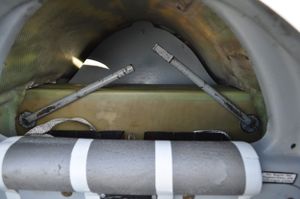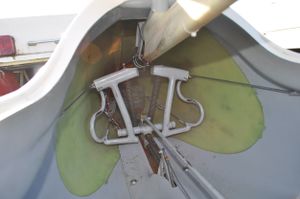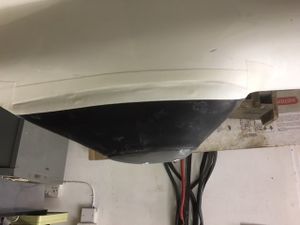CU Rigging Notes
v.12/2019
Maintenance information is in the Equipment officer’s guide.
Rigging CU is quite easy and two people who know what they are doing can rig in 20 minutes. However, ASW19s are at heightened risk of rigging related accidents due to their controls not being self connecting, so make sure you have rigged correctly. If in doubt check with someone who knows how to do it.
Contents
- 1 Pre-rigging notes
- 2 Parking the Trailer
- 3 Rigging
- 3.1 Preparation
- 3.2 Removing Fuselage
- 3.3 Connecting the starboard wing (right)
- 3.4 Connecting the port wing (left)
- 3.5 Inserting the main pins
- 3.6 Lower the wheel and remove from dolly
- 3.7 Connecting the tail plane
- 3.8 Connect the controls
- 3.9 Install total energy tube
- 3.10 Install batteries and parachute
- 3.11 Install Vertica (optional)
- 3.12 Install glide computer (optional)
- 3.13 Wing tape
- 3.14 Ballast weights (as needed)
- 4 Daily inspection
- 5 De-rig
- 6 Soartronics BT connector
Pre-rigging notes
Some basic rules and things to be aware of:
- Never rig the glider unless you are 100% sure you know what you are doing. If you are unsure get help from an Instructor or somebody who is familiar with an ASW19.
- Don’t get distracted or interrupted during the rigging process, this is how you forget something.
- Alway do a full DI and positive control checks before taking the glider to the launch point.
- Always get a full briefing and read the flight manual before a conversion flight.
- 60% of accidents caused by disconnected elevators happen on ASW19 or 20s, double check the elevator connections before flying.
Parking the Trailer
CU lives in the western trailer park at GRL. As of Summer 2020, between LA and an older SHK glider. When parking, attach the hitch to the permanent ball in the parking location. Make sure the handbrake is left off. Lower the rear stabilisers until they take the tension.
Rigging
You need at least 2 people to rig CU, but 3 is helpful if you are not feeling strong or the wind is high. CU's wings are particularly heavy, and holding the root might be a challenge if you are not confident. Feel free to ask anyone in the trailer park to help you rig, they should be happy to help, but the usual etiquette is that you will then help them with their wings. Don't take advantage of people!
Preparation
- Unlock trailer at both ends.
- Remove any boxes from the front of the trailer (these can get crushed when the lid opens).
- Open the trailer lid fully from the back.
- Remove trestles, ramp, ramp handles, etc. Be careful not to scratch the glider.
- Ensure the trailer is secured with the tow hitch attached to the permanent ball and the rear stabilisers taking the tension to stop it wobbling. This sets up the rear of the trailer at the correct height.
- Cover trailer corners and floor with carpet.
- Pull out the ramp, ensuring the pins engage in the slots at the end. Place the two securing bolts in the holes above these pins to stop the ramp popping out.
- Secure the ramp in the upright (raised) position using the red pin.
- Move wings out horizontally to the edge of the trailer to provide more fuselage clearance.
- Undo the strap that holds the tail down (this may not be attached when the trailer is parked).
Removing Fuselage
- Lift fuselage by the black strap around tail and slide it out of trailer until the belly dolly reaches the end of the ramp. Mind the top of the fin as you come out, and be careful not to trip over the ramp.
- Remove the strap though the fuselage, tennis balls and the tail strap. (Tennis balls may not be installed when the trailer is parked).
- Ensure the straps for the battery (behind your head when sitting in the glider) are clear of the space for the wing roots.
Connecting the starboard wing (right)
Always rig with the right wing first (this has the fork). Person 1 is the person in charge of the rig.
- Person 2 lifts the wing tip and slides the wing out of trailer. Mind the wing on the pins on the fuselage and on the edge of the trailer.
- Once fully out, person 1 lifts the root and carries it clear of the trailer.
- Person 2 rotates the wing 90 degrees so it is perpendicular to the fuselage.
- When ready, both people rotate the wing so that it is flat, and ready to slide into the fuselage.
- Person 1 places spar in hole in fuselage. Make sure that the fuselage doesn’t wobble.
- Both slide the wing in. Make sure that the control rods slide into the holes and don’t catch on the fuselage. Person 1 may have to instruct person 2 on whether they need to move the wing forwards/backwards/up/down so that it slides in flush. Make sure the gap between the wing is uniform and about 5-10mm.
- Person 1 places a trestle just outboard of the silver slide on the wing, being careful not to put the trestle on the aileron. Person 2 can relax.
Connecting the port wing (left)
Repeat as for the starboard wing, except place the trestle at the tip. Check again that the wing/fuse gaps are even and haven't changed with the second wing going in.
Inserting the main pins
Inserting the pins should be a quick an easy task taking less than a minute, if they are not going in the wings are not level and not aligned correctly. Do not blindly force the pins in; take a moment to step back and assess if its not easy. Make sure you give your wing tip holder a rest if it is taking a long time!
- Person 1 removes a pin from green bag (they are identical). This is stored on the seat cushion when the glider is de-rigged, or sometimes in the plastic box. Make sure they are greased; if not, then apply a little from the grease tub with the red lid in the plastic box.
- Look down the holes for the pins; you should be able to see if the holes line up or what needs doing to make them line up. Usually, person 2 on the port (left) wing needs to lift slightly.
- Person 1 gives instructions to person 2 whether to move the wing up/down/fwd/back. Keep checking that both wings are flush with the fuse.
- Put the starboard pin in first, all the way if you can.
- Repeat for the second pin.
- Rotate the pins so that handles meet at the bottom and lock them in place with the safety catch halfway between the pins.
- Person 2 can now relax.
Some people have success putting the first pin in half way, then getting the second pin in, and returning to the first. Do this if you are struggling. We also have a white machined plastic rigging aid in the green bag. You can put this in the holes and rotate it to attempt alignment.
Lower the wheel and remove from dolly
- Lower the main wheel using the lever in the cockpit. Take the opportunity to check the tyre and wheel brake condition.
- Lower the jack using the long bar; take the tension off the pin, pull the pin out, then gently lower the ramp.
- Gently push the glider backwards to be clear of the the belly dolly.
Connecting the tail plane
This step can be done before moving the glider off the dolly if required.
- Collect the tailplane bolt, allen key and wire tool from the green bag.
- Push the wing root dollies to the back of the trailer, out of the way.
- Person 1 & 2 stand in the trailer at each end of the tailplane, which is attached to the roof of the trailer.
- Person 2 (at the back of the trailer facing forwards) supports the tailplane.
- Person 1 (at the front facing backwards) pushes the handle on the roof mount to release the tail, making sure the tailplane doesn't drop.
- Remove the tailplane from the trailer and avoid scratching the glider or tripping over the ramp.
- Lower the tailplane onto the fin (putting the tailplane mount in the big square hole) and then push backwards firmly to lock in place.
- Use the metal wire to pull back the small metal loop on the top of the tail plane and place the bolt into the tailplane. Do the first few turns by hand to avoid cross threading, then tighten up with the allen key. Slot the wire lock into the closest bolt slot once it gets tight. Note that the metal loop is very fragile. If it gets damaged it will need cutting out of the tailplane, which is very expensive.
- Return the wire tool and allen key to the green bag.
Connect the controls
- Remove silver wing guards from each wing, careful not to bash the point where the aileron connectors are.
- Remove the fiberglass cover on the fuselage (you can use the same wire tool as is used for the elevator to open the flap).
- Trim the glider fully rearwards (nose up) to help with connecting the elevator.
- Connect each control by:
- Pulling down the collar
- Pushing the pin sideways through the rod
- Putting the socket over the ball
- Allowing pin to spring back
- Allowing collar to spring back
- Checking that pin cannot move fully when the collar is up
- The controls that need connecting are
- 1 x elevator (trim back before connecting)
- 2 x airbrakes (unlock air brakes by pulling the rods in)
- 2 x ailerons
- Ailerons and air brake controls can be accessed from the little panel behind the cockpit.
- Roll the connection around in your fingers and make sure it doesn't pop off.
- Once controls are connected, close and lock the little panel. Make sure that the little panel is taped up securely with a wing tape, as the locking mechanism does not lock it fully.
Install total energy tube
The total energy tube is kept in the pocket in the cockpit.
- Slide it into the hole in the fuselage halfway between the wings and the tail, with the two holes facing backwards.
- Don’t push too far, the lip on the total energy tube should be flush with the glider, don’t push it any further or you will damage the glider
- If it is pushed too far the tube would be blocked and there will not be any reading on the vario
Install batteries and parachute
The batteries are stored in the back of the hangar and are marked CU. The parachute is in a black bag in the bottom of the main CGC 'chute cupboard. Make sure to DI it like you would any 'chute.
- Batteries go into the holders behind the pilot's head and are held in by straps. Make sure the batteries aren't loose.
- Plug battery wires into the connectors.
Over time the battery life declines. Inform the equipment officer if they are running out of juice early in the day.
Install Vertica (optional)
- Vertia flight computer is kept in the CUGC box below the parachute room
- Plug in the usb power cable
- Place into holder (bottom first) and it will click into place
Install glide computer (optional)
- Mount the glide computer using the RAM x-grip mount in the centre of the instrument panel
- Adjust the positioning by slightly loosen the two screw handles, make sure NO INSTRUMENT IS COVERED BY THE PHONE, then tighten the two screws again
- Plug in the usb power cable. You may need an adaptor, since the cable has an old micro USB connector.
Wing tape
You should always tape up:
- The control connections access panel
- Base of the total energy tube
For improved performance you can also tape up:
- Gap between the wing and the fuselage x2
- Gap between the fin and the tailplane
- Over the tail plane bolt (avoid the little metal loop)
Ballast weights (as needed)
Ballast weights are stored in the CUGC shelf in the parachute room.
- Check ballast requirements and remember the conversion between ballast weight and equivalent pilot weight (x2.5)
- Ballast weights go in the nose
- Remove the nut (don’t lose it!)
- To add a ballast weight you will need to slightly close the canopy
- Replace the nut and secure the ballast weights
Daily inspection
During daily inspections make sure that you check the condition of the glider’s skid. If the bottom foot is worn, the glider is U/S and skid needs replacing. Please see a picture of new skid for reference.
The skid has been replaced in Sep 2019. Dragging with the skid on the ground should be avoided if possible and use of the tail dolly is preferred. Dragging on tarmac/concrete should be avoided at all. Inspection of the condition of the skid should be done as frequently as possible to monitor the wear.
De-rig
In general, the de-rig is just the reverse of the rig, but here are some extra pointers:
When bringing the fuselage onto the belly dolly, make sure you remove the tail dolly. The fuse' should be dragged onto the belly dolly so that the leading edge of the dolly is in line with the 'B' on the ASW 19B B lettering on the side of the fuse. This means it will seat nicely in the trailer. This can be tricky. If it's being really stubborn, pull the fuse on further once the wings are removed.
When packing up, avoid putting the tow out gear in the front (tow hook end) of the trailer as it can easily be squashed when the lid comes down.
Make sure to lock the trailer when you leave. The back door is tricky. Lean on the RHS of the lid and you should be able to close the door.
Soartronics BT connector
This is a device placed between the flarm and flarm display. It is essentially an serial connection to the flarm over the bluetooth. Once the flarm is powered on the device should be discoverable by bluetooth and should be paired to the mobile phone (PIN 1234 if prompted). With appropriate settings with the XCSoar, the following functions are supported:
- Flarm radar (display of the local traffic)
- Adjust flarm setting
- Declare task to the flarm IGC recorder before taking off
- GPS and barometric height (if your phone does not have a built-in GPS/barometer)
For more information please see:


